Synthesis of Novel Arginine-Based Flame Retardant and Its Application in Lyocell Fabric
Abstract
1. Introduction
2. Materials and Methods
2.1. Materials
2.2. Synthesis of Flame Retardant
2.3. Manufacture of Flame-Retardant Lyocell Fabric (FR-Lyocell)
2.4. Characterizations
3. Results and Discussion
3.1. Structure Characterization and Thermal Properties of Flame Retardants
3.2. Element Composition and Surface Morphologies of the Lyocell Fibers
3.2.1. XPS Analysis
3.2.2. SEM and EDS Analysis
3.3. FTIR Analysis
3.4. Thermal Stability Analysis
3.5. Burning Properties Analysis
3.6. Cone Calorimeter Analysis
3.7. Roman Spectrum
3.8. TG-IR Analysis
4. Conclusions
Author Contributions
Funding
Institutional Review Board Statement
Informed Consent Statement
Conflicts of Interest
References
- Seddon, H.; Hall, M.; Horrocks, A.-R. The flame retardancy of lyocell fibres. Polym. Degrad. Stab. 1996, 54, 401–402. [Google Scholar] [CrossRef]
- Kim, H.; Bai, B.; In, S.; Lee, Y.-S. Effects of an inorganic ammonium salt treatment on the flame-retardant performance of lyocell fibers. Carbon Lett. 2016, 17, 74–78. [Google Scholar] [CrossRef]
- Yang, G.-S.; Meng, Y.-W.; Zhang, H.-H.; Shao, H.-L. Application of lyocell fiber structure formation mechanism in flame-retardant modification of lyocell fiber. Cellul. Chem. Technol. 2020, 54, 1015–1022. [Google Scholar] [CrossRef]
- Joshi, H.-D.; Joshi, D.-H.; Patel, M.-G. Dyeing and finishing of lyocell union fibers: An industrial study. Coloration Technol. 2010, 126, 194–200. [Google Scholar] [CrossRef]
- Liu, Y.; Wang, Q.-Q.; Jiang, Z.-M.; Zhang, C.-J.; Li, Z.-F.; Chen, H.-Q.; Zhu, P. Effect of chitosan on the fire retardancy and thermal degradation properties of coated cotton fabrics with sodium phytate and APTES by LBL assembly. J. Anal. Appl. Pyrolysis 2018, 135, 289–298. [Google Scholar] [CrossRef]
- Hall, M.; Horrocks, A.-R.; Seddon, H. The flammability of lyocell. Polym. Degrad. Stab. 1999, 64, 502–510. [Google Scholar] [CrossRef]
- Liu, X.-H.; Zhang, Q.-Y.; Cheng, B.-W.; Ren, Y.-L.; Zhang, Y.-G.; Ding, C. Durable flame retardant cellulosic fibers modified with novel, facile and efficient phytic acid-based finishing agent. Cellulose 2018, 25, 799–811. [Google Scholar] [CrossRef]
- Li, P.; Wang, B.; Liu, Y.-Y.; Xu, Y.-J.; Jiang, Z.-M.; Dong, C.-H.; Zhang, L.; Liu, Y.; Zhu, P. Fully bio-based coating from chitosan and phytate for fire-safety and antibacterial cotton fabrics. Carbohydr. Polym. 2020, 237, 116173. [Google Scholar] [CrossRef]
- Bai, B.-C.; Kim, E.-A.; Jeon, Y.-P.; Lee, C.-W.; In, S.-J.; Lee, Y.-S.; Ji, S.-I. Improved flame-retardant properties of lyocell fiber achieved by phosphorus compound. Mater. Lett. 2014, 135, 226–228. [Google Scholar] [CrossRef]
- Li, Q.-L.; Huang, F.-Q.; Wei, Y.-J.; Wu, J.-Z.; Zhou, Z.; Liu, G. A phosphorus-nitrogen flame-retardant: Synthesis and application in cotton fabrics. Mater. Sci. Medžiagotyra 2018, 24, 448–452. [Google Scholar] [CrossRef]
- Li, P.; Liu, C.; Xu, Y.-J.; Jiang, Z.-M.; Liu, Y.; Zhu, P. Novel and eco-friendly flame-retardant cotton fabrics with lignosulfonate and chitosan through LbL: Flame retardancy, smoke suppression and flame-retardant mechanism. Polym. Degrad. Stab. 2020, 181, 109302. [Google Scholar] [CrossRef]
- Zhang, Q.-Y.; Liu, X.-H.; Ren, Y.-L.; Zhang, Y.-G.; Cheng, B.-W. Fabrication of a high phosphorus–nitrogen content modifier with star structure for effectively enhancing flame retardancy of lyocell fibers. Cellulose 2020, 27, 8369–8383. [Google Scholar] [CrossRef]
- Liu, X.-H.; Zhang, Y.-G.; Cheng, B.-W.; Ren, Y.-L.; Zhang, Q.-Y.; Ding, C.; Peng, B. Preparation of durable and flame retardant lyocell fibers by a one-pot chemical treatment. Cellulose 2018, 25, 6745–6758. [Google Scholar] [CrossRef]
- Wang, D.-F.; Zhong, L.; Zhang, C.; Li, S.-N.; Tian, P.-X.; Zhang, F.-X.; Zhang, G.-X. Eco-friendly synthesis of a highly efficient phosphorus flame retardant based on xylitol and application on cotton fabric. Cellulose 2019, 26, 2123–2138. [Google Scholar] [CrossRef]
- Han, G.-J.; Zhao, X.-Y.; Feng, Y.-Z.; Ma, J.-M.; Zhou, K.-Q.; Shi, Y.-Q.; Liu, C.-T.; Xie, X.-L. Highly flame-retardant epoxy-based thermal conductive composites with functionalized boron nitride nanosheets exfoliated by one-step ball milling. Chem. Eng. J. 2021, 407, 127099. [Google Scholar] [CrossRef]
- Mengal, N.; Syed, U.; Malik, S.-A.; Sahito, I.-A.; Jeong, S.-H. Citric acid based durable and sustainable flame retardant treatment for lyocell fabric. Carbohydr. Polym. 2016, 153, 78–88. [Google Scholar] [CrossRef]
- Liu, S.-D.; Chen, Y.; Wan, C.-Y.; Wang, P.; Zhang, G.-X. A novel high durability flame retardant with phosphoric acid ester groups and a reactive ammonium phosphorus acid group for cotton fabrics. Cellulose 2021, 28, 2479–2493. [Google Scholar] [CrossRef]
- Luo, H.-Q.; Rao, W.-H.; Liu, Y.-L.; Zhao, P.; Wang, L.; Yu, C.-B. Novel multi-element DOPO derivative toward low-flammability epoxy resin. J. Appl. Polym. Sci. 2020, 137, 49427. [Google Scholar] [CrossRef]
- Carbon Nitride Hybrids as Halogen-Free Flame Retardants for Polyamide 6. Polymers 2020, 12, 2323. [CrossRef]
- Cheng, X.-W.; Wu, Y.-X.; Huang, Y.-T.; Jiang, J.-R.; Xu, J.-T.; Guan, J.-P. Synthesis of a reactive boron-based flame retardant to enhance the flame retardancy of silk. React. Funct. Polym. 2020, 156, 104731. [Google Scholar] [CrossRef]
- Walong, A.; Thongnuanchan, B.; Sakai, T.; Lopattananon, N. Influence of silicon dioxide addition and processing methods on structure, thermal stability and flame retardancy of EVA/NR blend nanocomposite foams. Prog. Rubber Plast. Recycl. Technol. 2020, 37, 49–65. [Google Scholar] [CrossRef]
- Jiang, L.-N.; Ren, Y.-L. Study on modified viscose fiber blended with silane coated intumescent flame retardant. J. Text. Sci. Eng. 2020, 37, 58–64. [Google Scholar]
- Liu, H.; Wu, H.-J.; Song, Q.-Y.; Zhang, J.-Y.; Li, W.-H.; Qu, H.-Q. Core/shell structure magnesium hydroxide @ polyphosphate metal salt: Preparation and its performance on the fame retardancy for ethylene vinyl acetate copolymer. J. Therm. Anal. Calorim. 2020, 141, 1341–1350. [Google Scholar] [CrossRef]
- Guo, X.-C.; Liu, N.; Li, L.-T.; Bai, Z.-Y.; Chen, X.-L.; Zhou, D.-F.; Qin, J.; Zhang, K.; Lu, Z.-C. The synergistic flame retardancy of modified expandable graphite and metal hydroxides on HDPE/EVA composites. J. Thermoplast. Compos. Mater. 2020. [Google Scholar] [CrossRef]
- Alongi, J.; Tata, J.; Frache, A. Hydrotalcite and nanometric silica as finishing additives to enhance the thermal stability and flame retardancy of cotton. Cellulose 2011, 18, 179–190. [Google Scholar] [CrossRef]
- Zhang, S.-M.; Fan, X.-S.; Xu, C.-C.; Ji, P.; Wang, C.-S.; Wang, H.-P. An inherently flame-retardant polyamide 6 containing a phosphorus group prepared by transesterification polymerization. Polymer 2020, 207, 122890. [Google Scholar] [CrossRef]
- Vothi, H.; Nguyen, C.; Pham, L.; Hoang, D.-Q.; Kim, J. Novel nitrogen−phosphorus flame retardant based on phosphonamidate: Thermal stability and flame retardancy. ACS Omega 2019, 18, 17791–17797. [Google Scholar] [CrossRef]
- Brahmia, F.-Z.; Zsolt, K.; Horvath, P.-G.; Alpar, T.-L. Comparative study on fire retardancy of various wood species treated with PEG 400, phosphorus, and boron compounds for use in cement-bonded wood-based products. Surf. Interfaces 2020, 21, 100736. [Google Scholar] [CrossRef]
- Hu, X.; Yang, H.-Y.; Jiang, Y.-P.; He, H.-L.; Liu, H.-Y.; Huang, H.; Wan, C.-J. Facile synthesis of a novel transparent hyperbranched phosphorous/nitrogen-containing flame retardant and its application in reducing the fire hazard of epoxy resin. J. Hazard. Mater. 2019, 379, 1207930. [Google Scholar] [CrossRef] [PubMed]
- Moustafa, H.; Darwish, N.; Nour, M.; Youssef, A. Biodegradable date stones filler for enhancing mechanical, dynamic, and flame retardant properties of polyamide-6 biocomposites. Polym. Compos. 2018, 39, 1978–1987. [Google Scholar] [CrossRef]
- Santanu, B.; Wazed, A. Fire resistant behaviour of cellulosic textile functionalized with wastage plant bio-molecules: A comparative scientific report. Biol. Macromol. 2018, 114, 169–180. [Google Scholar]
- Xu, F.; Zhong, L.; Xu, Y.; Zhang, C.; Wang, P.; Zhang, F.-X.; Zhang, G.-X. Synthesis of three novel amino acids-based flame retardants with multiple reactive groups for cotton fabrics. Cellulose 2019, 26, 7537–7552. [Google Scholar] [CrossRef]
- Su, X.-W.; Cheng, C.-Z.; Zheng, Y.-B.; Liu, X.-H.; Ren, Y.-L.; He, J.; Lin, S.-G.; Cheng, B.-W. A novel biomass vitamin B6-based flame retardant for lyocell fibers. Cellulose 2021, 28, 3201–3214. [Google Scholar] [CrossRef]
- Liu, X.-H.; Zhang, Q.-Y.; Peng, B.; Ren, Y.-L.; Cheng, B.-W.; Ding, C.; Su, X.-W.; He, J.; Lin, S.-G. Flame retardant cellulosic fabrics via layer-by-layer self-assembly double coating with egg white protein and phytic acid. J. Clean. Prod. 2020, 243, 118641. [Google Scholar] [CrossRef]
- Ren, Y.-L.; Tian, T.; Jiang, L.-N.; Liu, X.-H.; Han, Z.-B. Polyvinyl Alcohol Reinforced Flame-Retardant Polyacrylonitrile Composite Fiber Prepared by Boric Acid Cross-Linking and Phosphorylation. Materials 2018, 11, 2391. [Google Scholar] [CrossRef] [PubMed]
- Razmjooei, F.; Singh, K.-P.; Bae, E.-J.; Yu, J.-S. A new class of electroactive Fe- and P-functionalized graphene for oxygen reduction. J. Mater. Chem. A 2015, 3, 11031. [Google Scholar] [CrossRef]
- Wu, Y.-X.; Huang, Y.-T.; Guan, J.-P.; Cheng, X.-W.; Xu, J.-T.; Chen, G.-Q. Facile preparation of effective flame retardant silk fabric by the metal salt adsorption approach. Polym. Degrad. Stab. 2020, 182, 109378. [Google Scholar] [CrossRef]
- Nabipour, H.; Wang, X.; Song, L.; Hu, Y. Graphene oxide/zeolitic imidazolate frameworks-8 coating for cotton fabrics with highly flame retardant, self-cleaning and efficient oil/water separation performances. Mater. Chem. Phys. 2020, 256, 123656. [Google Scholar] [CrossRef]
- Carran, R.-S.; Ghosh, A.; Dyer, J.-M. The effects of zeolite molecular sieve based surface treatments on the properties of wool fabrics. Appl. Surf. Sci. 2013, 287, 467–472. [Google Scholar] [CrossRef]
- Zhang, Y.; Ren, Y.-L.; Liu, X.-H.; Huo, T.-G.; Qin, Y.-W. Preparation of durable flame retardant PAN fabrics based on amidoximation and phosphorylation. Appl. Surf. Sci. 2018, 428, 395–403. [Google Scholar] [CrossRef]
- Liu, X.-H.; Ding, C.; Peng, B.; Ren, Y.-L.; Cheng, B.-W.; Lin, S.-G.; He, J.; Su, X.-W. Synthesis and application of a new, facile, and efficient sorbitol-based finishing agent for durable and flame retardant lyocell fibers. Cellulose 2020, 27, 3427–3442. [Google Scholar] [CrossRef]
- Wang, L.-H.; Ren, Y.-L.; Wang, X.-L.; Zhao, J.-Y.; Zhang, Y.; Zeng, Q.; Gu, Y.-T. Fire retardant viscose fiber fabric produced by graft polymerization of phosphorus and nitrogen-containing monomer. Cellulose 2016, 23, 2689–2700. [Google Scholar] [CrossRef]
- Li, X.-H.; Chen, H.-Y.; Wang, W.-T.; Liu, Y.-Q.; Zhao, P.-H. Synthesis of a formaldehyde-free phosphorus nitrogen flame retardant with multiple reactive groups and its application in cotton fabrics. Polym. Degrad. Stab. 2015, 120, 193–202. [Google Scholar] [CrossRef]
- Tian, P.-X.; Liu, M.-S.; Wan, C.-Y.; Zhang, G.-X.; Zhang, F.-X. Synthesis of a formaldehyde-free flame retardant for cotton fabric. Cellulose 2019, 26, 9889–9899. [Google Scholar] [CrossRef]
- Wan, C.-Y.; Liu, M.-S.; Tian, P.-X.; Zhang, G.-X.; Zhang, F.-X. Renewable vitamin B5 reactive N-P flame retardant endows cotton with excellent fire resistance and durability. Cellulose 2020, 27, 1745–1761. [Google Scholar] [CrossRef]
- Liu, M.-S.; Huang, S.; Zhang, G.-X.; Zhang, F.-X. An efficient anti-flaming phosphorus-containing guanazole derivative for cotton fabric. Cellulose 2019, 26, 2791–2804. [Google Scholar] [CrossRef]
- Liu, M.-S.; Huang, S.; Zhang, G.-X.; Zhang, F.-X. Synthesis of P–N–Si synergistic flame retardant based on a cyclodiphosphazane derivative for use on cotton fabric. Cellulose 2019, 26, 7553–7567. [Google Scholar] [CrossRef]
- Ren, Y.-L.; Liu, Y.-S.; Wang, Y.; Guo, X.; Liu, X.-H. Preparation of durable and flame retardant lyocell fabrics by using a biomass-based modifier derived from vitamin C. Cellulose 2020, 27, 6677–6689. [Google Scholar] [CrossRef]
- Peng, H.-Y.; Wang, D.; Li, M.; Zhang, L.-P.; Liu, M.-M.; Fu, S.-S. Ultra-small SiO2 nanospheres self-pollinated on flower-like MoS2 for simultaneously reinforcing mechanical, thermal and flame-retardant properties of polyacrylonitrile fiber. Compos. Part B Eng. 2019, 174, 107037. [Google Scholar] [CrossRef]
- Luo, Y.-F.; Wang, S.; Fu, X.-H.; Du, X.-S.; Wang, H.-B.; Zhou, M.; Cheng, X.; Du, Z.-L. Fabrication of a bio-based superhydrophobic and flame-retardant cotton fabric for oil–water separation. Macromol. Mater. Eng. 2021, 306, 2000624. [Google Scholar] [CrossRef]
- Chen, L.; Wang, Y.-Z. A review on flame retardant technology in China. Part I: Development of flame retardants. Polym. Adv. Technol. 2010, 21, 1–26. [Google Scholar] [CrossRef]
- Zhao, B.; Liu, Y.-T.; Zhang, C.-Y.; Liu, D.-Y.; Li, F.; Liu, Y.-Q. A novel phosphoramidate and its application on cotton fabrics: Synthesis, flammability and thermal degradation. J. Anal. Appl. Pyrolysis 2017, 125, 109–116. [Google Scholar] [CrossRef]
- Chen, X.-L.; Wang, W.-D.; Jiao, C.-M. A recycled environmental friendly flame retardant by modifying para-aramid fiber with phosphorus acid for thermoplastic polyurethane elastomer. J. Hazard. Mater. 2017, 331, 257–264. [Google Scholar] [CrossRef] [PubMed]
- Ma, Y.-H.; Wang, J.; Zhang, Y.-S. TG–FTIR study on pyrolysis of waste printing paper. J. Therm. Anal. Calorim. 2017, 129, 1225–1232. [Google Scholar] [CrossRef]
- Yan, X.; Zhou, W.-L.; Zhao, X.-S.; Xu, J.-J.; Liu, P.-Q. Preparation flame retardancy and thermal degradation behaviors of polyacrylonitrile fibers modified with diethylenetriamine and zinc ions. J. Therm. Anal. Calorim. 2016, 124, 719–728. [Google Scholar] [CrossRef]

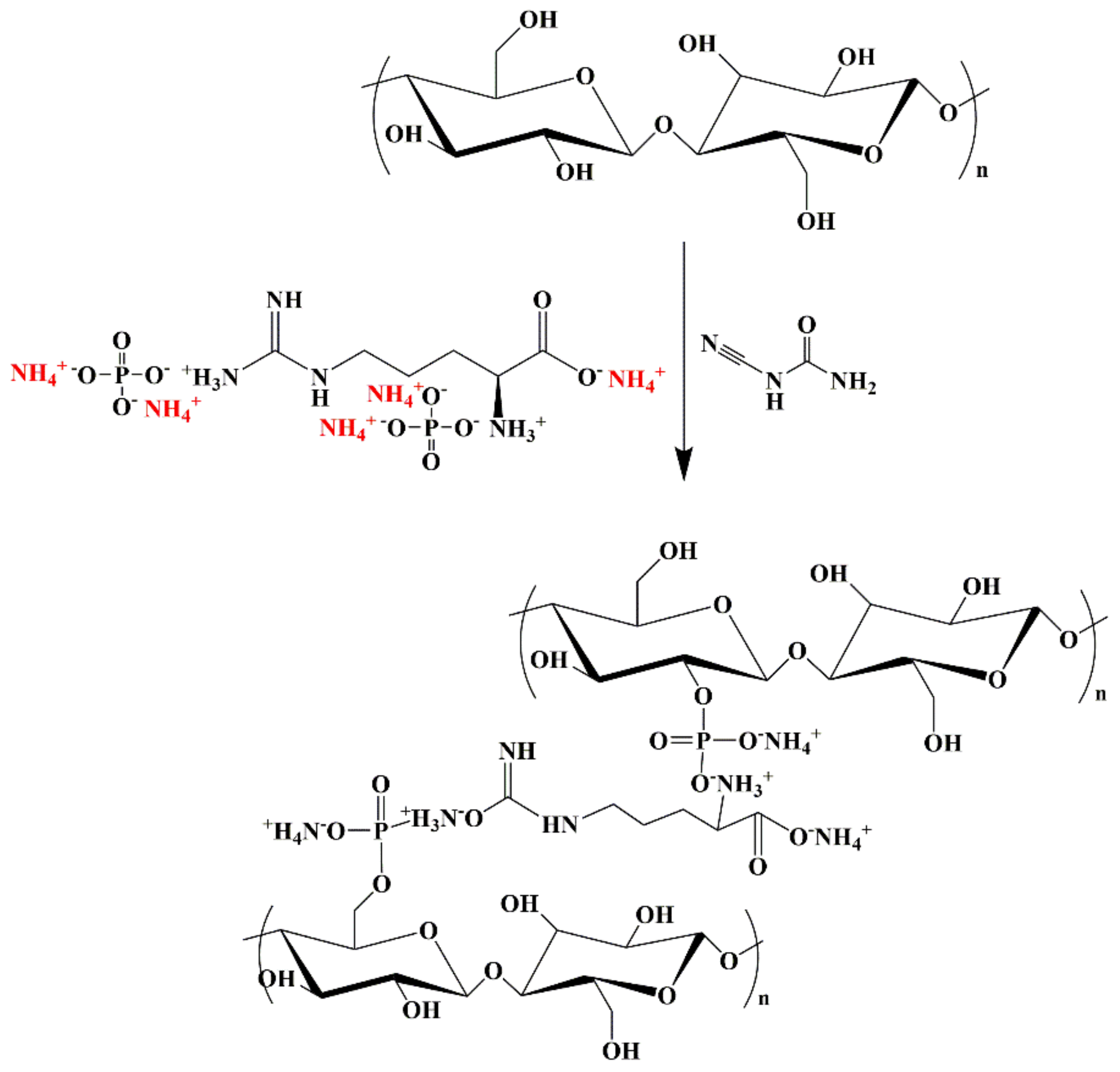

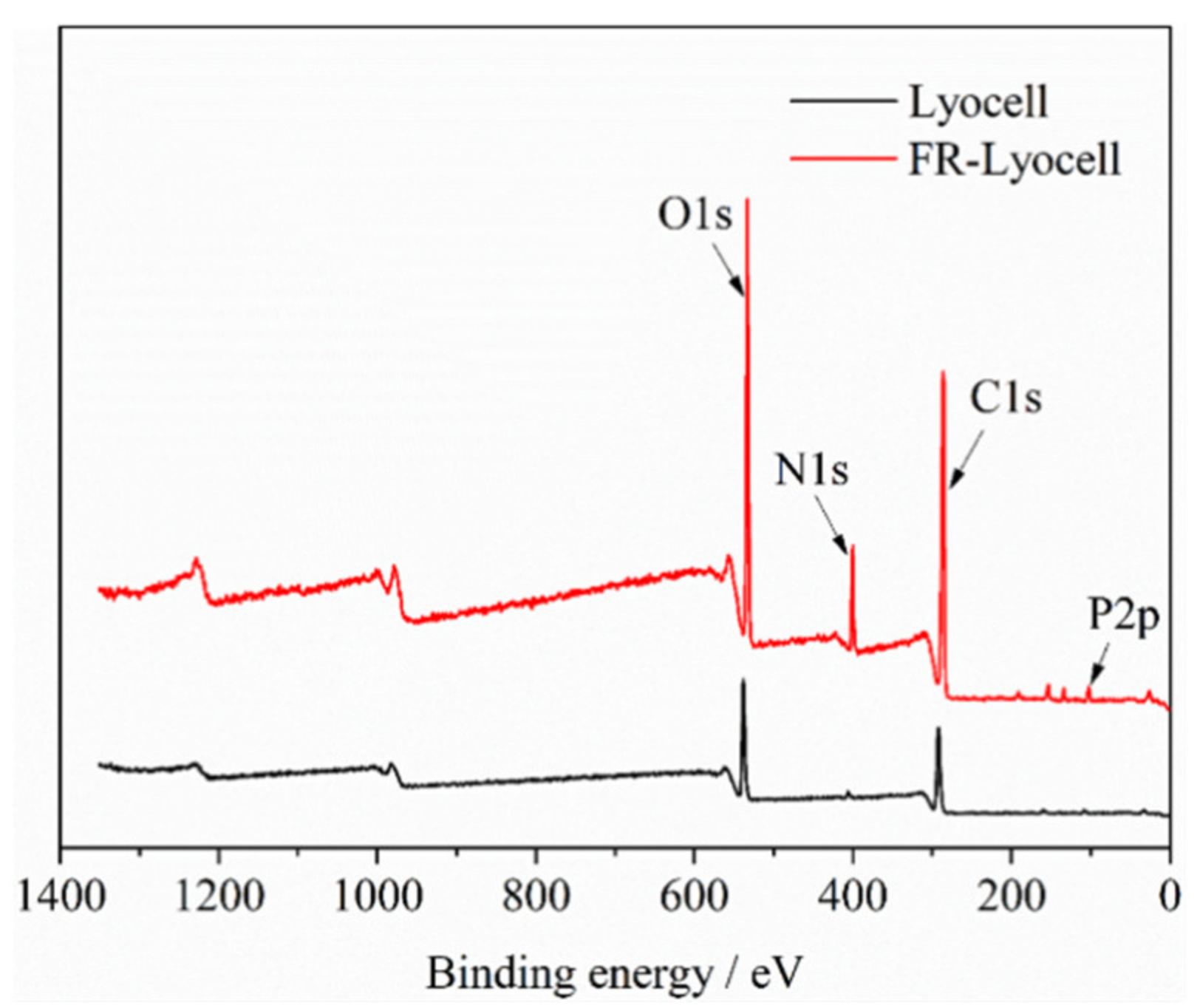
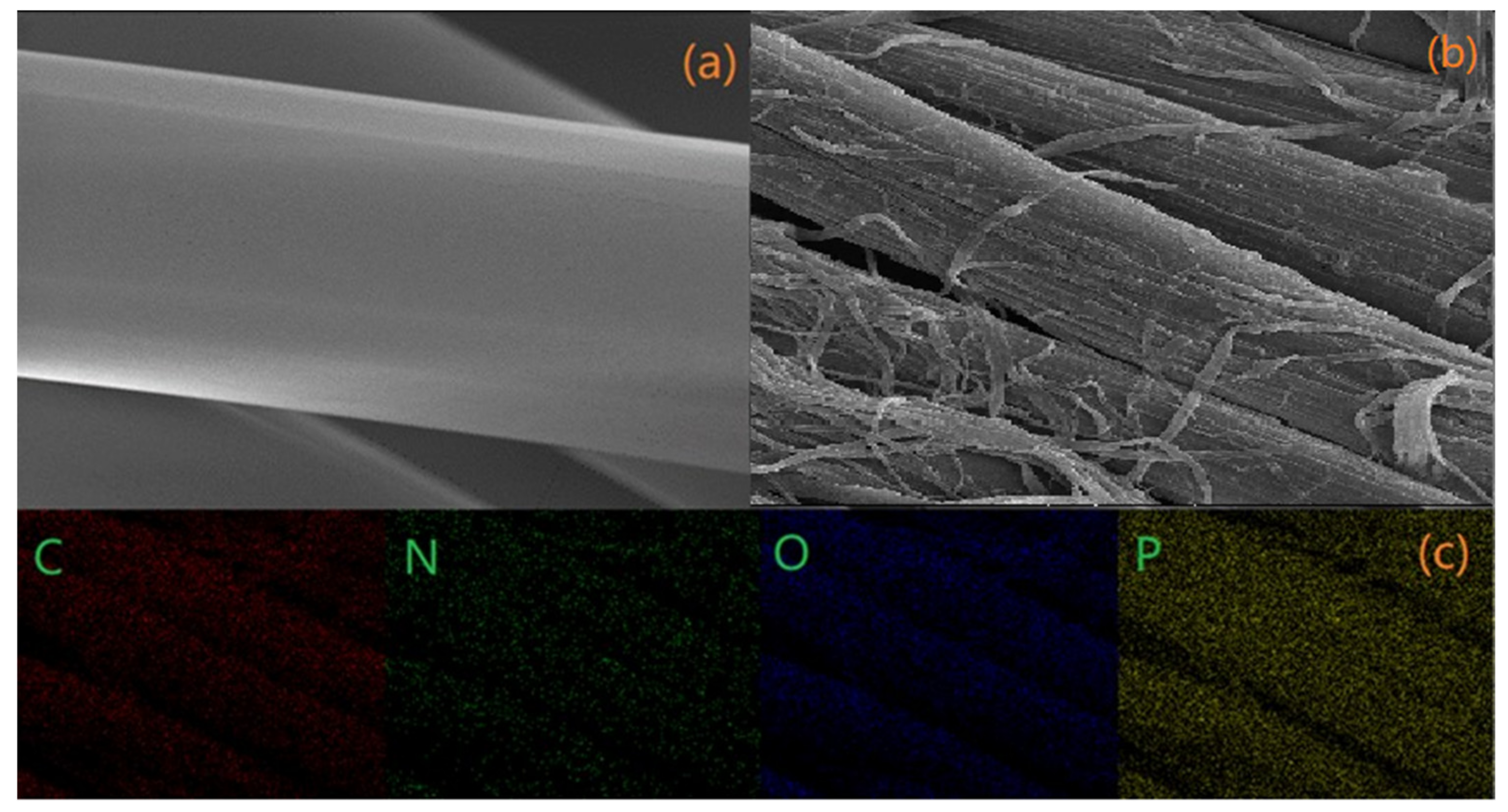
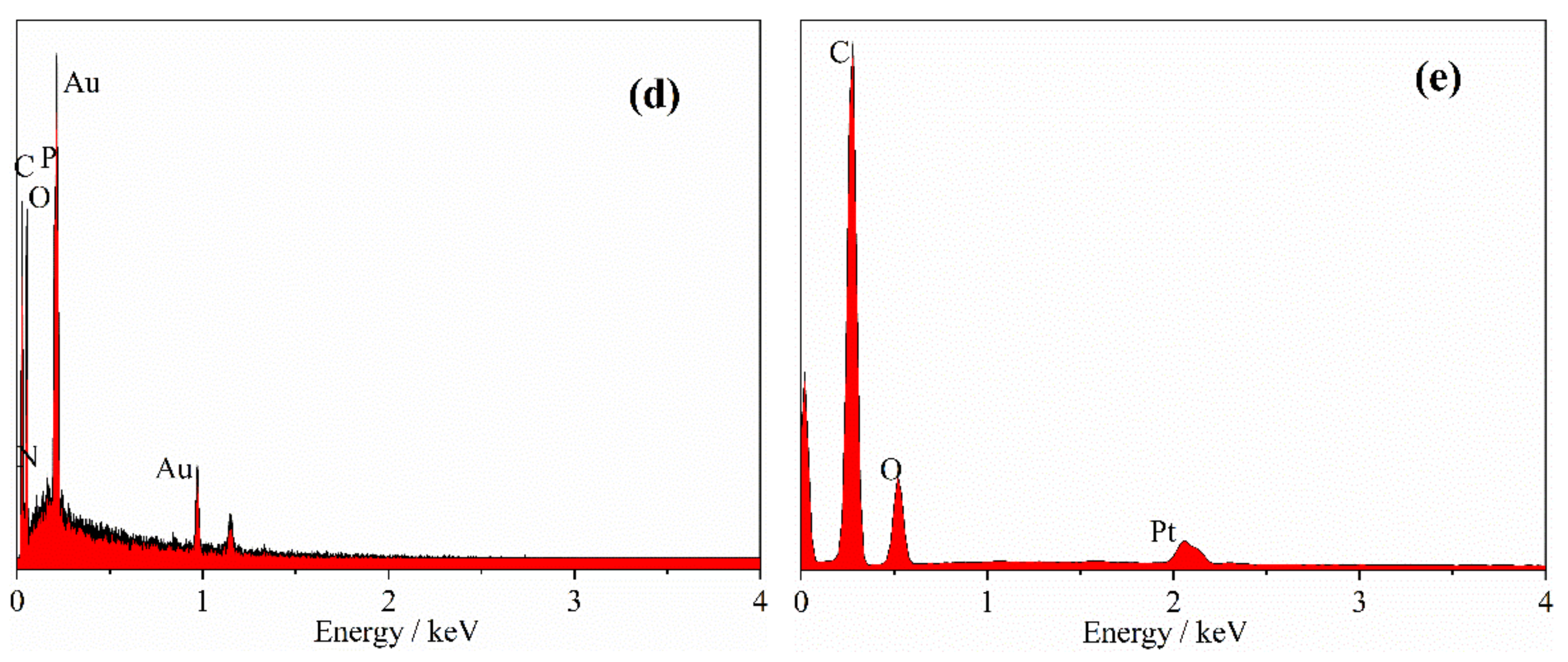
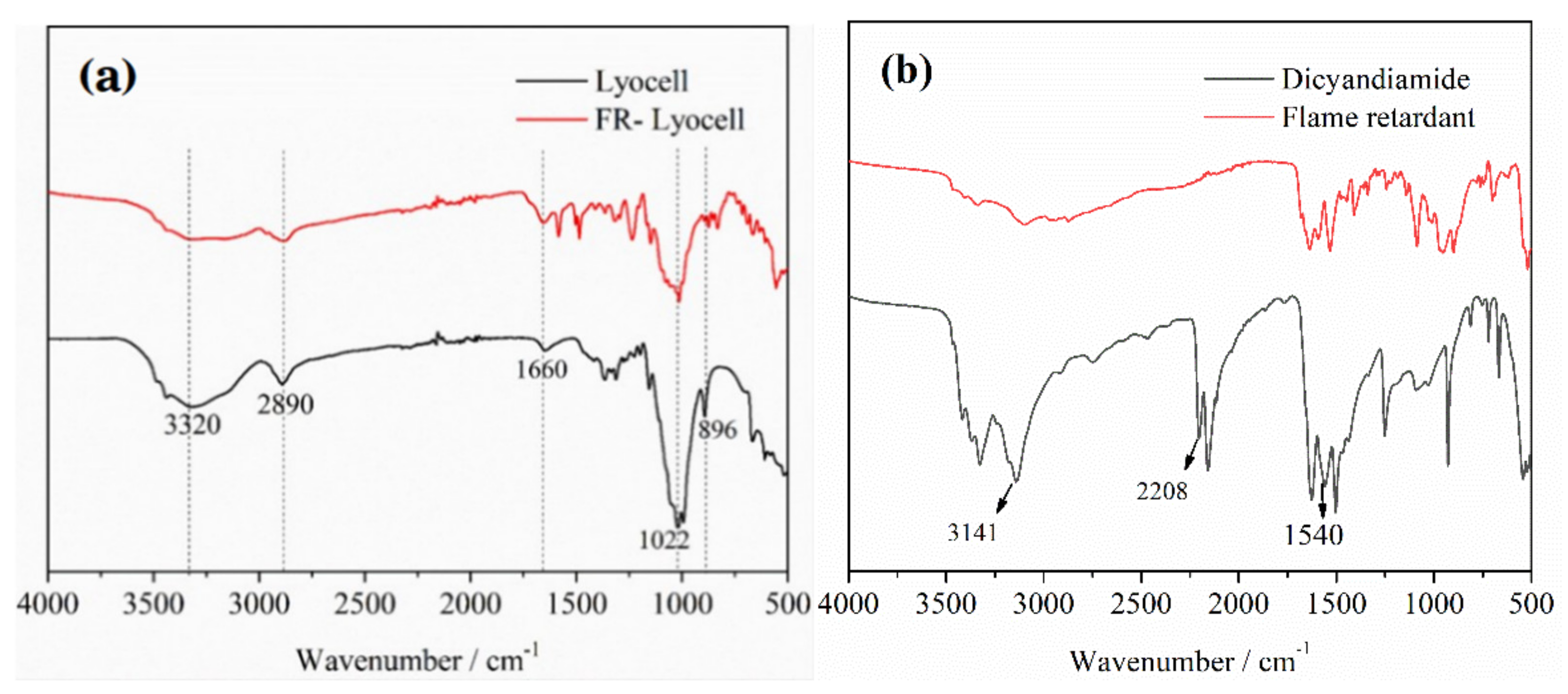
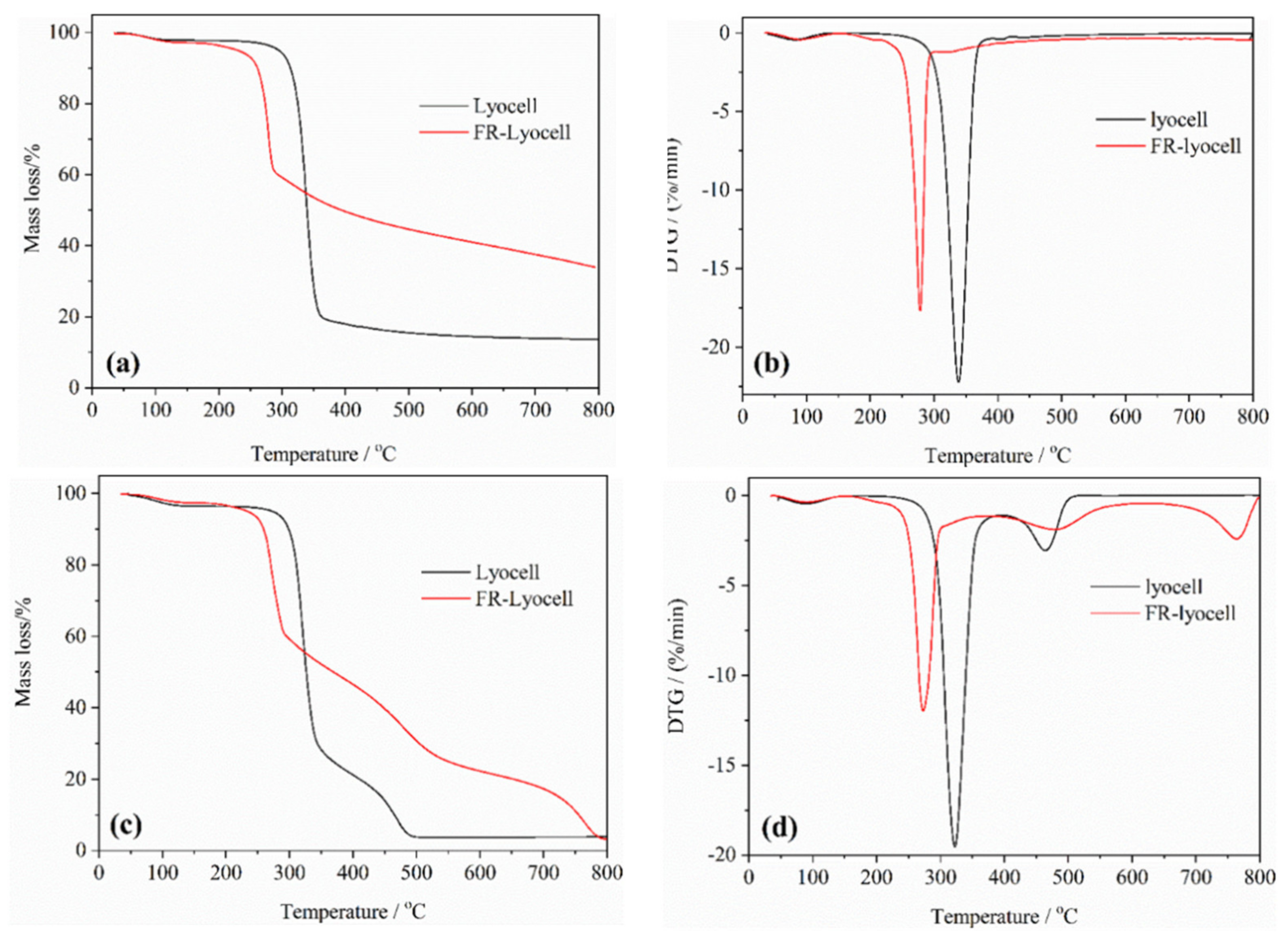
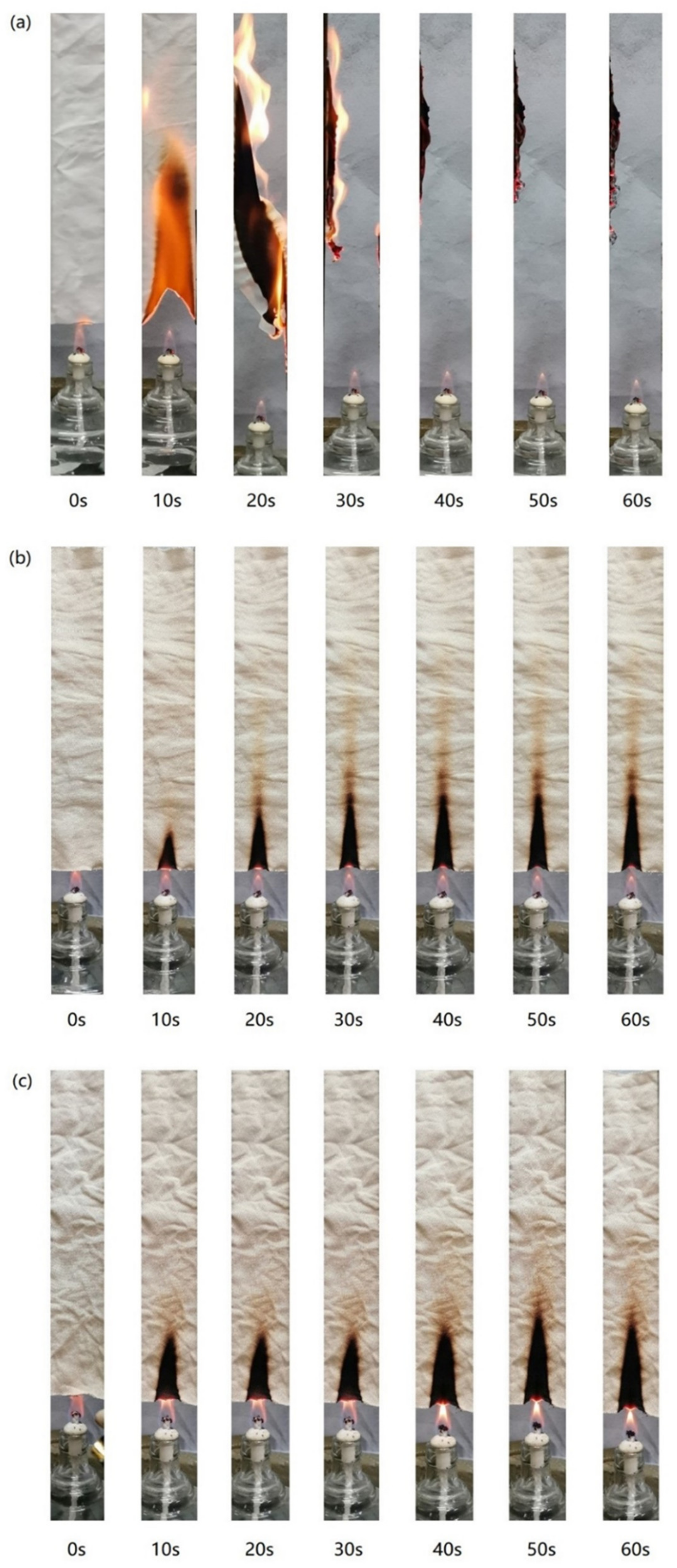
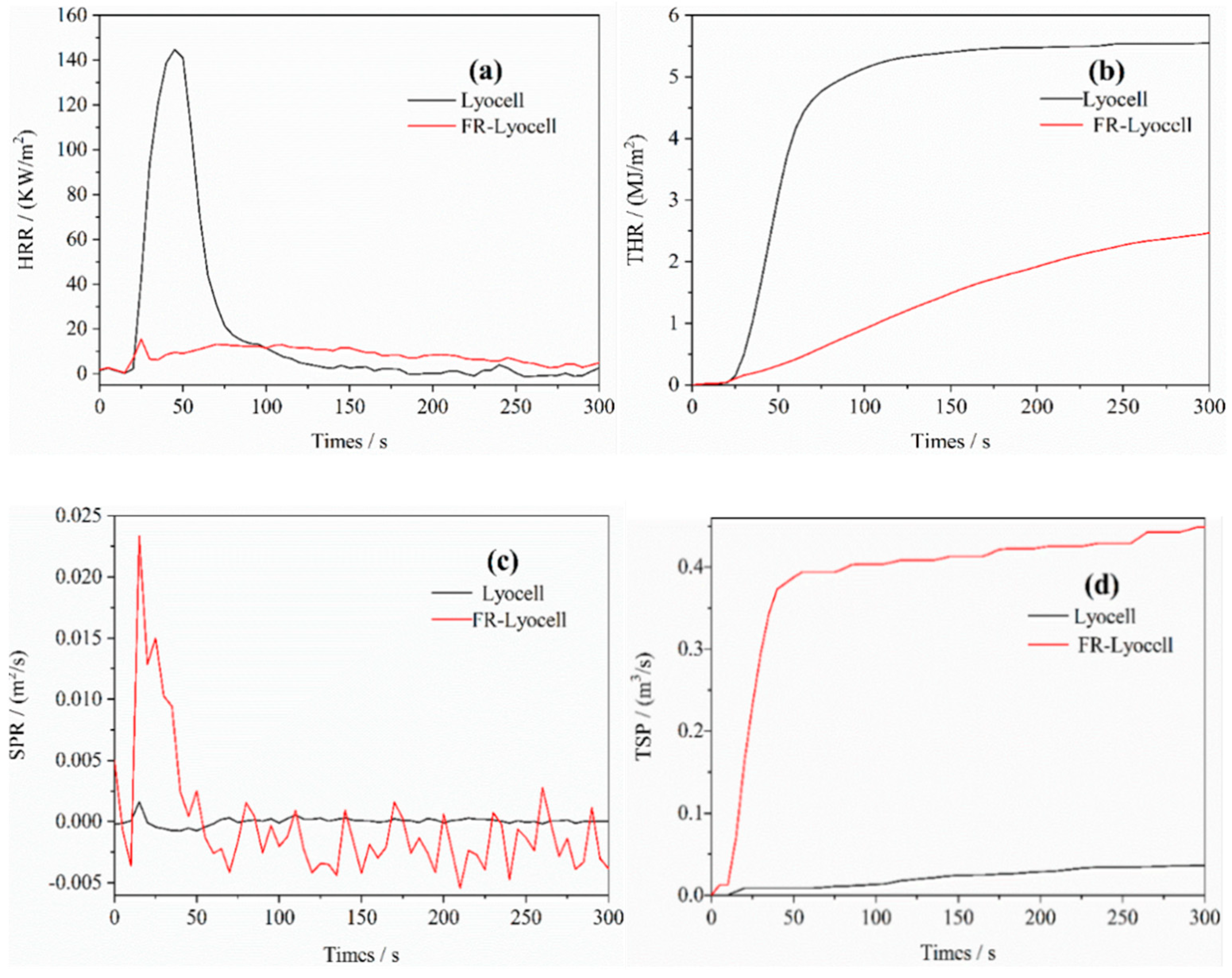
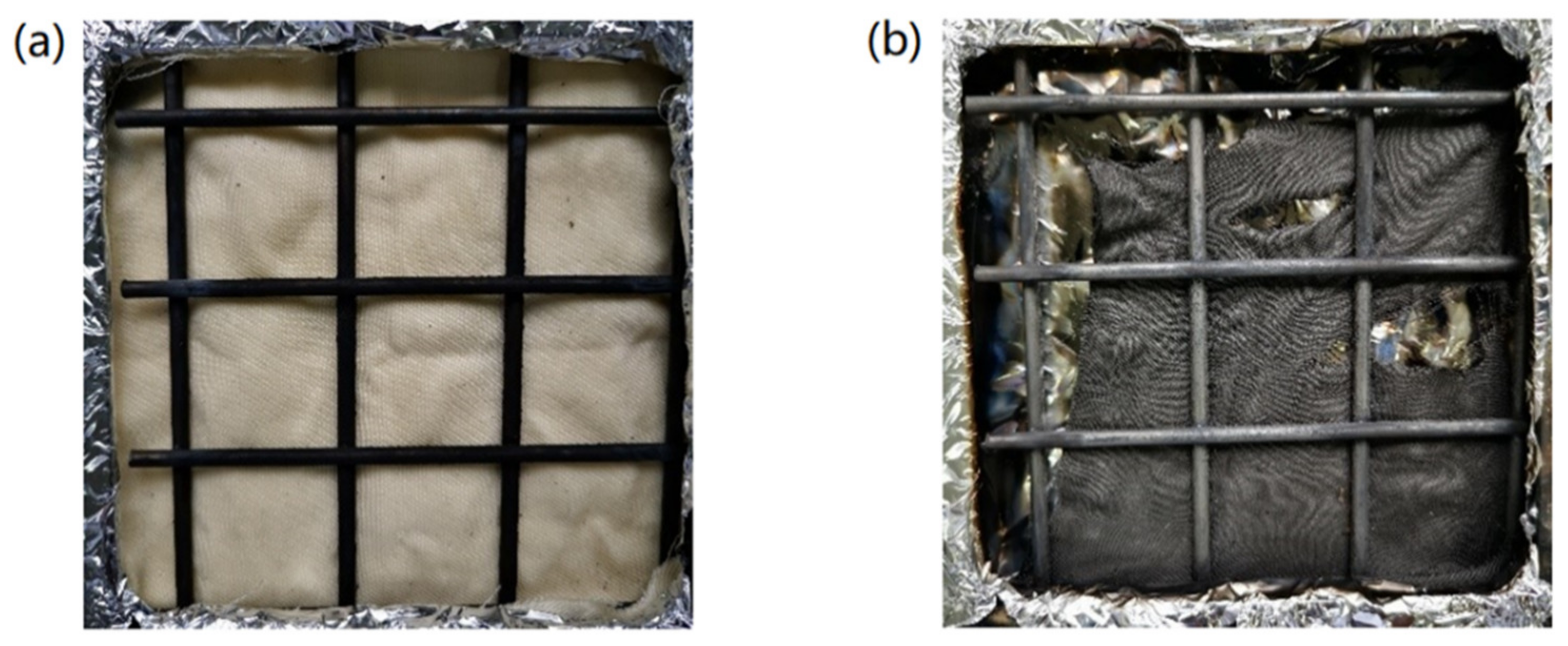



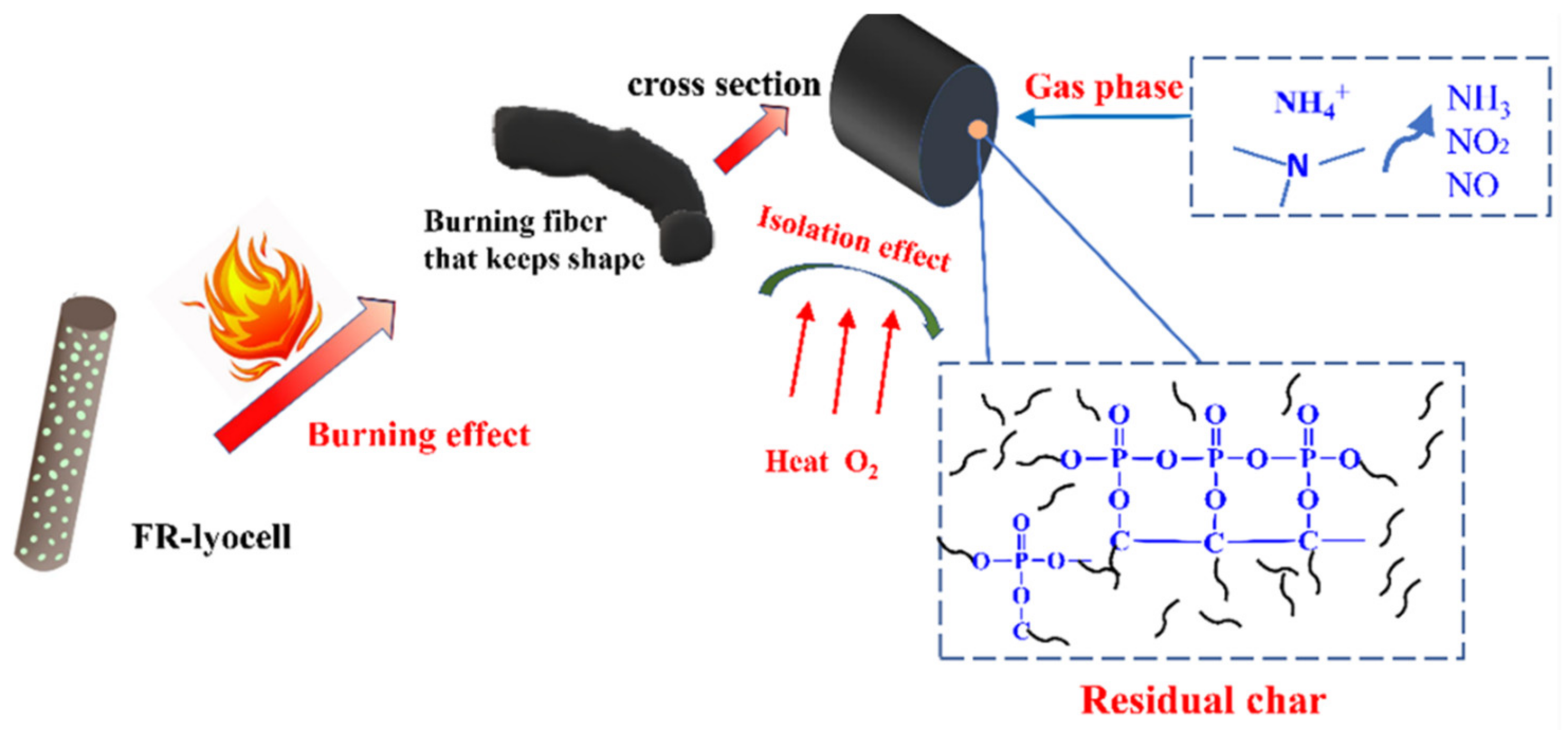
| Sample | Concentration (g/L) | Weight Gain (%) | Average Weight Gain (%) |
|---|---|---|---|
| 1-1 | 120 | 5.3 | 7.3 |
| 1-2 | 120 | 6.7 | |
| 1-3 | 120 | 10.0 | |
| 2-1 | 150 | 7.3 | 8.9 |
| 2-2 | 150 | 8.7 | |
| 2-3 | 150 | 10.7 | |
| 3-1 | 180 | 11.3 | 11.5 |
| 3-2 | 180 | 10.0 | |
| 3-3 | 180 | 13.1 |
| Sample | C (wt%) | O (wt%) | N (wt%) | P (wt%) |
|---|---|---|---|---|
| Lyocell | 64.5 | 30.6 | - | - |
| FR-lyocell | 61.2 | 25.7 | 9.5 | 1.2 |
| Atmosphere | Sample | T5% (°C) | T50% (°C) | T max (°C) | Residue at 800 °C (wt%) |
|---|---|---|---|---|---|
| N2 | lyocell | 295.0 | 339.5 | 337.3 | 13.6 |
| FR-lyocell | 229.4 | 394.1 | 278.1 | 33.7 | |
| Air | lyocell | 273.0 | 326.5 | 333.0 | 3.9 |
| FR-lyocell | 234.1 | 369.1 | 272.8 | 3.3 |
| Sample | LOI Values (%) | |||||
|---|---|---|---|---|---|---|
| 0 | 2 | 4 | 6 | 8 | 10 | |
| lyocell | 17.0 | |||||
| FR-lyocell | 39.5 ± 0.1 | 39.0 ± 0.1 | 38.8 ± 0.1 | 38.5 ± 0.1 | 38.5 ± 0.1 | 37 ± 0.1 |
| Sample | TTI (s) | PHRR (kW/m2) | TPHRR (s) | THR (MJ/m2) | PSPR (m2/s) | TSP (m2) | Residue (wt%) | FIGRA (kW/m2s) |
|---|---|---|---|---|---|---|---|---|
| Lyocell | 18.0 | 144.7 | 45.0 | 5.5 | 0 | 0 | 8.8 | 3.2 |
| FR-lyocell | 16.0 | 15.4 | 25.0 | 2.4 | - | 0.4 | 34.3 | 0.6 |
Publisher’s Note: MDPI stays neutral with regard to jurisdictional claims in published maps and institutional affiliations. |
© 2021 by the authors. Licensee MDPI, Basel, Switzerland. This article is an open access article distributed under the terms and conditions of the Creative Commons Attribution (CC BY) license (https://creativecommons.org/licenses/by/4.0/).
Share and Cite
Chen, J.; Liu, Y.; Zhang, J.; Ren, Y.; Liu, X. Synthesis of Novel Arginine-Based Flame Retardant and Its Application in Lyocell Fabric. Molecules 2021, 26, 3588. https://doi.org/10.3390/molecules26123588
Chen J, Liu Y, Zhang J, Ren Y, Liu X. Synthesis of Novel Arginine-Based Flame Retardant and Its Application in Lyocell Fabric. Molecules. 2021; 26(12):3588. https://doi.org/10.3390/molecules26123588
Chicago/Turabian StyleChen, Jiayi, Yansong Liu, Jiayue Zhang, Yuanlin Ren, and Xiaohui Liu. 2021. "Synthesis of Novel Arginine-Based Flame Retardant and Its Application in Lyocell Fabric" Molecules 26, no. 12: 3588. https://doi.org/10.3390/molecules26123588
APA StyleChen, J., Liu, Y., Zhang, J., Ren, Y., & Liu, X. (2021). Synthesis of Novel Arginine-Based Flame Retardant and Its Application in Lyocell Fabric. Molecules, 26(12), 3588. https://doi.org/10.3390/molecules26123588





